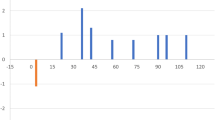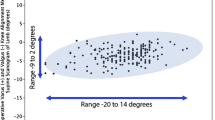Abstract
Purpose
Appropriate positioning and alignment of tibial and femoral component in primary total knee arthroplasty (TKA) are factors of major importance directly related to patient satisfaction and implant survival. Most literature works elaborate on overall post-operative alignment and its correlation to implant survival. However, less is known about the impact of individual component alignment. The purpose of this study was to investigate the effect of undercorrection of overall alignment as well as the effect of individual tibial and femoral component alignment on the post-operative failure rate after total knee arthroplasty.
Methods
Clinical and radiographic data of primary TKA cases from 2002 to 2004, with a minimum of 10-year follow-up, were retrospectively reviewed. The pre- and post-operative hip–knee–ankle angle (HKA), mechanical lateral distal femoral angle (mLDFA) and mechanical medial proximal tibial angle (mMPTA) were measured on weight-bearing, full-length antero-posterior lower limb radiographs. Statistical analysis was performed to establish the correlation between both overall and implant alignment and revision rate.
Results
In total, 379 primary TKA cases were evaluated. The mean time of follow-up was 12.9 years (range 10.3–15.9 years, SD = 1.8). Nine out of 379 cases were revised due to aseptic loosening; the mean time to revision was 5.5 years (range 1.0–15.5 years, SD = 4.6). Varus undercorrection of overall alignment was not associated with a higher rate of revision (p = 0.316). Post-operative valgus femoral alignment (mLDFA < 87°) contributed to a significant decreased prosthesis survival in contrast to neutral femoral alignment (revision rate valgus group: 10.7% and neutral group: 1.7%; p = 0.003). Post-operative tibial mechanical alignment was not identified as a significant predictor for implant survival (revision rate varus group: 2.9% and neutral group: 2.4%; p = 0.855).
Conclusions
Primary TKA showed significantly higher revision rates when the femoral component was placed in > 3° of valgus (mLDFA < 87°). In contrast, postoperative overall residual varus alignment (HKA) and varus alignment of the tibial component were not related to higher revision rates at a minimum 10-year follow-up after TKA. These findings should be considered when choosing component position in individualised TKA.
Level of evidence
III.

Similar content being viewed by others
Data availability
The data of this study are available from the corresponding author upon request.
References
Bargren JH, Blaha JD, Freeman MA (1983) Alignment in total knee arthroplasty: correlated biomechanical and clinical observations. Clin Orthop Relat Res 173:178–183
Bäthis H, Perlick L, Tingart M, Lüring C, Zurakowski D, Grifka J (2004) Alignment in total knee arthroplasty: a comparison of computer-assisted surgery with the conventional technique. J Bone Jt Surg Br 86(5):682–687
Bellemans J, Colyn W, Vandenneucker H, Victor J (2012) The Chitranjan Ranawat Award: is neutral mechanical alignment normal for all patients? The concept of constitutional varus. Clin Orthop Relat Res 470:45–53
Berend ME, Ritter MA, Meding JB, Faris PM, Keating EM, Redelman R et al (2004) The Chetranjan Ranawat Award: tibial component failure mechanisms in total knee arthroplasty. Clin Orthop Relat Res 428:26–34
Bland JM, Altman D (1986) Statistical methods for assessing agreement between two methods of clinical measurement. Lancet. https://doi.org/10.1016/S0140-6736(86)90837-8
Bonner T, Eardley W, Patterson P, Gregg P (2011) The effect of post-operative mechanical axis alignment on the survival of primary total knee replacements after a follow-up of 15 years. J Bone Jt Surg Br 93(9):1217–1222
Calliess T, Ettinger M, Savov P, Karkosch R, Windhagen H (2018) Individualized alignment in total knee arthroplasty using image-based robotic assistance: video article. Orthopade 47(10):871–879
Cooke TDV, Sled EA, Scudamore RA (2007) Frontal plane knee alignment: a call for standardized measurement. J Rheumatol 34(9):1796–1801
D’Lima DD, Chen PC, Colwell CW (2001) Polyethylene contact stresses, articular congruity, and knee alignment. Clin Orthop Relat Res 392:232–238
Dorr LD, Boiardo RA (1986) Technical considerations in total knee arthroplasty. Clin Orthop Relat Res 205:5–11
Dossett H, Estrada N, Swartz G, LeFevre G, Kwasman B (2014) A randomised controlled trial of kinematically and mechanically aligned total knee replacements: two-year clinical results. J Bone Jt Surg Br 96(7):907–913
Dossett HG, Swartz GJ, Estrada NA, LeFevre GW, Kwasman BG (2012) Kinematically versus mechanically aligned total knee arthroplasty. Orthopedics 35(2):e160–e169
Fang DM, Ritter MA, Davis KE (2009) Coronal alignment in total knee arthroplasty: just how important is it? J Arthroplasty 24(6):39–43
Howell SM, Howell SJ, Kuznik KT, Cohen J, Hull ML (2013) Does a kinematically aligned total knee arthroplasty restore function without failure regardless of alignment category? Clin Orthop Relat Res 471:1000–1007
Jeffery RS, Morris RW, Denham RA (1991) Coronal alignment after total knee replacement. J Bone Jt Surg Br 73(5):709–714
Kim YH, Park JW, Kim JS, Park SD (2014) The relationship between the survival of total knee arthroplasty and postoperative coronal, sagittal and rotational alignment of knee prosthesis. Int Orthop 38:379–385
Lotke PA, Ecker ML (1977) Influence of positioning of prosthesis in total knee replacement. J Bone Jt Surg Am 59(1):77–79
Magnussen RA, Weppe F, Demey G, Servien E, Lustig S (2011) Residual varus alignment does not compromise results of TKAs in patients with preoperative varus. Clin Orthop Relat Res 469:3443–3450
Morgan SS, Bonshahi A, Pradhan N, Gregory A, Gambhir A, Porter M (2008) The influence of postoperative coronal alignment on revision surgery in total knee arthroplasty. Int Orthop 32:639–642
Oussedik S, Abdel MP, Victor J, Pagnano MW, Haddad FS (2020) Alignment in total knee arthroplasty: what’s in a name? J Bone Jt Surg Br 102(3):276–279
Paley D, Pfeil J (2000) Principles of deformity correction around the knee. Orthopade 29(1):18–38
Parratte S, Pagnano MW, Trousdale RT, Berry DJ (2010) Effect of postoperative mechanical axis alignment on the fifteen-year survival of modern, cemented total knee replacements. J Bone Jt Surg Am 92(12):2143–2149
Ritter MA, Davis KE, Meding JB, Pierson JL, Berend ME, Malinzak RA (2011) The effect of alignment and BMI on failure of total knee replacement. J Bone Jt Surg Br 93(17):1588–1596
Ritter MA, Faris PM, Keating EM, Meding JB (1994) Postoperative alignment of total knee replacement. Its effect on survival. Clin Orthop Relat Res 299:153–156
Salzmann M, Fennema P, Becker R, Hommel H (2017) Does postoperative mechanical axis alignment have an effect on clinical outcome of primary total knee arthroplasty? A retrospective cohort study. Open Orthop J 11:1330–1336
Srivastava A, Lee GY, Steklov N, Colwell CW Jr, Ezzet KA, D’Lima DD (2012) Effect of tibial component varus on wear in total knee arthroplasty. Knee 19(5):560–563
Theodore W, Twiggs J, Kolos E, Roe J, Fritsch B, Dickison D et al (2017) Variability in static alignment and kinematics for kinematically aligned TKA. Knee 24(4):733–744
Vanlommel L, Vanlommel J, Claes S, Bellemans J (2013) Slight undercorrection following total knee arthroplasty results in superior clinical outcomes in varus knees. Knee Surg Sports Traumatol Arthrosc 21(10):2325–2330
Xf W, Yang Y, Wang D, Xu H, Huang C, Zk Z et al (2022) Comparison of outcomes after total knee arthroplasty involving postoperative neutral or residual mild varus alignment: a systematic review and meta-analysis. Orthop Surg 14(2):177–189
Yeo JH, Seon JK, Lee DH, Song EK (2019) No difference in outcomes and gait analysis between mechanical and kinematic knee alignment methods using robotic total knee arthroplasty. Knee Surg Sports Traumatol Arthrosc 27(4):1142–1147
Zhou K, Ling T, Xu Y, Li J, Yu H, Wang H et al (2018) Effect of individualized distal femoral valgus resection angle in primary total knee arthroplasty: a systematic review and meta-analysis involving 1300 subjects. Int J Surg 50:87–93
Funding
No outside funding or grants were received related to the subject of this article.
Author information
Authors and Affiliations
Contributions
TL: Main Author, data analysis, drafting and editing of the manuscript. RM: Second author, data analysis, drafting and editing of the manuscript. HG, LS: Data analysis, drafting and editing of the manuscript. HV: Revision of the manuscript.
Corresponding author
Ethics declarations
Conflict of interest
Thomas Luyckx: This author, their immediate family, and any research foundation with which they are affiliated did not receive any financial payments or other benefits from any commercial entity related to the subject of this article. Robin Moreels: This author, their immediate family, and any research foundation with which they are affiliated did not receive any financial payments or other benefits from any commercial entity related to the subject of this article. Hannah Geernaert: This author, their immediate family, and any research foundation with which they are affiliated did not receive any financial payments or other benefits from any commercial entity related to the subject of this article. Lennart Scheys: This author, their immediate family, and any research foundation with which they are affiliated did not receive any financial payments or other benefits from any commercial entity related to the subject of this article. Hilde Vandenneucker: This author, their immediate family, and any research foundation with which they are affiliated did not receive any financial payments or other benefits from any commercial entity related to the subject of this article.
Ethical approval
This is an ethical board approved investigation (University Hospitals of Leuven, Belgium). S57373(ML11211).
Informed consent
Informed consent was obtained from all patients included in the study.
Additional information
Publisher's Note
Springer Nature remains neutral with regard to jurisdictional claims in published maps and institutional affiliations.
Rights and permissions
Springer Nature or its licensor (e.g. a society or other partner) holds exclusive rights to this article under a publishing agreement with the author(s) or other rightsholder(s); author self-archiving of the accepted manuscript version of this article is solely governed by the terms of such publishing agreement and applicable law.
About this article
Cite this article
Luyckx, T., Moreels, R., Geernaert, H. et al. Valgus alignment of the femoral component is associated with higher revision rates 10 years after TKA. Knee Surg Sports Traumatol Arthrosc 31, 4171–4178 (2023). https://doi.org/10.1007/s00167-023-07448-2
Received:
Accepted:
Published:
Issue Date:
DOI: https://doi.org/10.1007/s00167-023-07448-2




